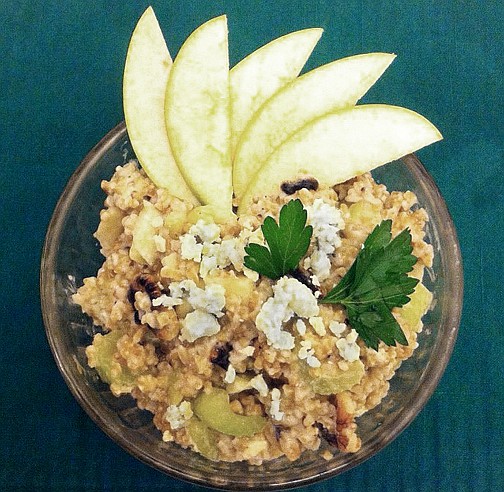A Smart Guide to Eating Gluten-Free the Healthy Way
April 10, 2014 at 2:22 p.m.
Are you following a gluten-free diet? If so, this story might sound familiar: For years you suffered digestive difficulties, until you received a diagnosis of celiac disease or gluten intolerance. The solution, said your doctor, was simple: Stop eating gluten-containing grains (wheat, rye, barley). You embraced gluten-free substitutes, your tummy troubles improved, and you felt great. Then, slowly, digestive issues crept back in. What happened?
May is Celiac Awareness Month. A gluten-free diet is necessary treatment for anyone afflicted with either celiac disease or gluten intolerance, but removing gluten doesn’t alone ensure long-term health. Some gluten-free products are low in nutrients; a healthy gluten-free diet must be carefully planned to meet or surpass the quality of the diet you gave up.
Whole wheat is higher in protein, fiber and minerals than many gluten-free grains. For example, a half-cup serving of whole wheat flour contains about 8 g protein, 7 g fiber, 1 mg iron, and 30 percent of your daily value for thiamin (a B-vitamin needed for energy). Conversely, a half-cup serving of brown rice contains only about 3 g protein, 2 g fiber, 10 percent of your daily value for thiamin, and a trace amount of iron.
All grains lose vitamins, minerals, protein and fiber when the outer hull is removed in refining, but rice and corn lose more than wheat. White rice flour has scant protein, while all-purpose wheat flour still contains 6 g per half-cup. Wheat Chex, for example, has 6 g fiber and 5 g protein, while Rice Chex only contains 1 g fiber and 2 g protein. Wheat flour products are often enriched after refining, which means iron and crucial B-vitamins like folate, niacin and thiamin are restored. This doesn’t always happen for gluten-free products, which leaves many deficient in certain nutrients and high in simple carbohydrates.
A gluten-free diet’s reduction in fiber can contribute to later digestive problems. One study found that people fed a refined gluten-free diet experienced a decrease in healthy and increase in unhealthy gut bacteria after only one month. Fiber is food for the good bacteria in our gut, which is critical for nearly every intestinal function, including immune protection, proper digestion, and protection against pathogenic bacteria like C. difficile. The fiber in whole grains, fruits and vegetables that we do not digest travels down the digestive tract to nourish the bacteria we need for health.
A smart gluten-free diet is rich in fiber, protein, vitamins and minerals, and can be even healthier than a gluten-containing one. Focus on a variety of tasty gluten-free whole grains in addition to rice and corn, like teff, amaranth, buckwheat, oats, quinoa and wild rice. Bake with high-protein nut or bean-based flours like coconut, almond or chickpea. Oats (make sure to buy certified gluten-free, meaning that they have been processed in a facility without wheat cross-contamination) contain 5 g fiber, 7 g protein, and 10 percent of your daily iron needs in a half-cup. Superfood seed-grains amaranth and quinoa are high in protein and can contain 9 g and 5 g fiber per half-cup, respectively, as well as B-vitamins.
Choose the actual grains whenever possible, rather than refined products: A bowl of warm quinoa makes a great breakfast. Sprinkle nuts and seeds like almonds or ground flax on top of cereal to add extra fiber, and ensure that your diet includes ample fruit, vegetables and beans.
For a fiber-rich gluten-free dish, try this oat pilaf:
Waldorf Oat Pilaf
This savory recipe makes a tasty dish for any time of day. It contains blue cheese, which is actually free of gluten even though it is cultivated from a bread mold.
1 cup gluten-free steel cut oats (such as Bob’s Red Mill)
1½ cups water
½ teaspoon salt
½ cup walnuts
1 small green apple, diced
2 stalks celery, diced
1/3 cup crumbled blue cheese
¼ cup dried cranberries
2 tablespoons olive oil
2 tablespoons red wine vinegar
Salt and pepper, to taste
Dry-toast oats in a saucepan on high heat, add water and salt, bring to a boil, and then reduce heat and simmer, covered, for 20 minutes. Scoop oats into a large bowl and cool for 10-15 minutes. Meanwhile, toast walnuts in a hot skillet until fragrant, about 5-7 minutes. Toss walnuts with oats, apple, celery, blue cheese, cranberries, oil and vinegar. Add additional salt and pepper if needed.
Serves: 4
Total time: 40 minutes
Copyright 2014, A. Bermann, Original recipe
Reviewed by Alexandra Kazaks, PhD, RD and Cynthia Lair. Non-profit, accredited Bastyr University (bastyr.edu) offers multiple degrees in the natural health sciences, and clinical training at Bastyr Center for Natural Health (bastyrcenter.org), the region’s largest natural medicine clinic.





